 |
 |
 |
 |
 |
 |
 |
 |
 |
 |
|
KICP Workshops & Events
|
PhD Thesis Defenses, 2010 Valentin Kostov, "Average luminosity distance in inhomogeneous universes" March 18, 2010 Online Materials Scientific Advisor: Edward W. Kolb Using numerical ray tracing, the paper studies how the average distance modulus in an inhomogeneous universe differs from its homogeneous counterpart. The averaging is over all directions from a fixed observer not over all possible observers (cosmic), thus it is more directly applicable to our observations. Unlike previous studies, the averaging is exact, non-perturbative, and includes all possible non-linear effects. The inhomogeneous universes are represented by Sweese-cheese models containing random and simple cubic lattices of mass-compensated voids. The Earth observer is in the homogeneous cheese which has an Einstein - de Sitter metric. For the first time, the averaging is widened to include the supernovas inside the voids by assuming the probability for supernova emission from any comoving volume is proportional to the rest mass in it. Despite the well known argument for photon flux conservation, the average distance modulus correction at low redshifts is not zero due to the peculiar velocities. A formula for the maximum possible average correction as a function of redshift is derived and shown to be in excellent agreement with the numerical results. The actual average correction calculated in random and simple cubic void lattices is severely damped below the predicted maximal average. That is traced to cancelations between the corrections coming from the fronts and backs of different voids at the same redshift from the observer. The calculated correction at low redshifts allows one to readily predict the redshift at which the averaged fluctuation in the Hubble diagram is below a required precision and suggests a method to extract the background Hubble constant from low redshift data without the need to correct for peculiar velocities. Related Links: KICP Members: Edward W. Kolb KICP Students: Valentin Kostov Stephanie A. Wissel, "Observations of Direct Cerenkov Light in Ground-Based Telescopes and the Flux of Iron Nuclei at TeV Energies" March 31, 2010 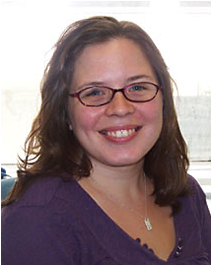 Scientific Advisor: Scott P. Wakely Cosmic rays with energies up to at least a few PeV are confined by the magnetic fields in galaxy and therefore, expected to be accelerated within it. While there is currently no direct evidence for it, diffusive shock acceleration in supernova remnants remains the prevailing theory that explains the origin of galactic cosmic rays. Strong magnetic fields close to the shock confine particles to the shock. The particles adiabatically cross the shock and gain energy, with some probability of escaping the acceleration region that is dependent on the ratio of momentum and charge (rigidity). The finite lifetime of supernova remnants implies that particles can only be accelerated to some maximum energy, expected to be ~3Z × 1015–17 eV, where Z is the charge of the particle. Measuring the composition of cosmic rays accurately at high energies is a unique experimental problem, because flux of all cosmic rays falls steeply with energy. Experiments flown above the Earth's atmosphere achieve elemental and sometimes isotopic charge resolution, but become limited by statistics at the few TeV/amu regime, because of their limited collecting area. Ground-based telescopes can expand the collecting area by using the atmosphere as a calorimeter and estimating the charge from the air shower properties, but have limited charge resolution. By measuring the Cerenkov radiation of the primary particle, the direct Cerenkov method is shown here to measure the flux of cosmic rays with better than 25% charge resolution. The TrICE experiment was designed to discover direct Cherenkov radiation, by exploiting the inherent timing and angular separation between the direct Cerenkov radiation and the Cerenkov radiation produced in the particle air shower. TrICE was capable of imaging high-resolution showers using a multi-anode photomultiplier camera with angular resolution of 0.086°. While DC light was not observed over the background in TrICE, VERITAS can select for DC events by using stereoscopic techniques. VERITAS achieves a charge resolution of 21.5% and an energy resolution of 16.5%. The flux of iron nuclei are measured from 22 TeV to 141 TeV, and can be described by a power law given by (5.8 ± 0.84stat ± 1.2sys) × 10-7(E/50 TeV)-2.84±0.30stat±0.3sys TeV-1 m-2 sr-1 s-1. The data agree well with direct measurements from satellite- and balloon-borne experiments, as well as the measurements made by H.E.S.S. using the same technique. Related Links: KICP Members: Scott P. Wakely KICP Students: Stephanie A. Wissel Scientific projects: Very Energetic Radiation Imaging Telescope Array System (VERITAS) Felipe Marin, "The large-scale three-point correlation function of SDSS luminous red galaxies" June 1, 2010 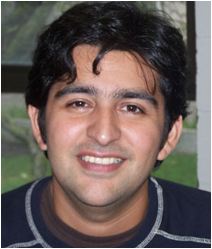 Scientific Advisor: Joshua A. Frieman We present new measurements of the redshift-space three-point correlation function (3PCF) of Luminous Red Galaxies (LRGs) from the Sloan Digital Sky Survey (SDSS). Using the largest dataset to date, the Data Release 7 (DR7) LRGs, and an improved binning scheme compared to previous measurements, we measure the LRG 3PCF on large scales up to ~ 90 h-1 Mpc, from the mildly non-linear to quasi-linear regimes. Comparing the LRG correlations to the dark matter two- and three-point correlation functions, obtained from N-body simulations we infer linear and nonlinear bias parameters. As expected, LRGs are highly biased tracers of large scale structure, with a linear bias b1 ~ 2; the LRGs also have a large positive non-linear bias parameter, in agreement with predictions of galaxy population models. The use of the 3PCF to estimate biasing helps to also make estimates of the cosmological parameter sigma8, as well as to infer best-fit parameters of the Halo Occupation Distribution parameters for LRGs. We also use a large suite of public mock catalogs to characterize the error covariance matrix for the 3PCF and compare the variance among simulation results with jackknife error estimates. Related Links: KICP Members: Joshua A. Frieman KICP Students: Felipe Marin Scientific projects: Sloan Digital Sky Survey (SDSS) Colin Bischoff, "Observing the Cosmic Microwave Background Polarization Anisotropy at 40 GHz with QUIET" June 21, 2010 | 1:00 PM | RI 180 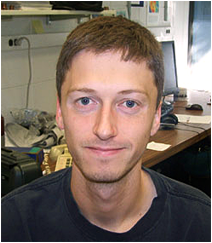 Scientific Advisor: Bruce D. Winstein The Cosmic Microwave Background has proven to be an invaluable tool for cosmology, but much of the scientific information contained in its polarization anisotropy is still to be discovered. Of particular interest is the angular power spectrum of the tiny B-mode polarization signal, the divergence free component which is geometrically distinct from the dominant E-modes. The theory of inflation, which has been proposed to explain several curious features of our universe, predicts the existence of B-mode fluctuations on large angular scales and at a signal level that may be achievable in the near future. The Q/U Imaging Experiment (QUIET) is designed to make sensitive measurements of the CMB polarization using arrays of integrated "detectors on a chip" that can be scaled to reach the sensitivity requirements for detecting B-modes. This thesis covers the design of QUIET, which consists of separate instruments for observation at 40 and 90 GHz. After the discussion of the detectors, which generally applies to both instruments, the remaining sections focus on observations, calibration, and data analysis for the 40 GHz detector. Tests performed on the data indicate some not-yet-identified source of contamination that must be understood and corrected before a reliable result can be obtained. Related Links: KICP Members: Bruce D. Winstein KICP Students: Colin Bischoff Scientific projects: Q/U Imaging ExperimenT (QUIET) Ryan Keisler, "Measurements of Cosmic Microwave Background Anisotropy with the South Pole Telescope" November 1, 2010 | 1:30 PM | LASR Conference room 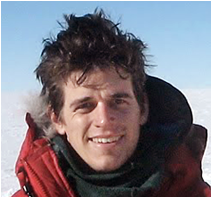 We present a measurement of the angular power spectrum of the cosmic microwave background (CMB) using data from the South Pole Telescope (SPT), a 10-meter aperture, mm-wave telescope located at the geographic South Pole. We describe the instrument, the data reduction, and the power spectrum analysis. We present preliminary constraints on cosmological parameters using this power spectrum. We find that the data are consistent with a flat ΛCDM cosmology and improve the constraints on the standard cosmological parameters. We find evidence for gravitational lensing of the CMB and provide strong constraints on excursions from this standard cosmological model. Related Links: KICP Members: John E. Carlstrom KICP Students: Ryan Keisler Scientific projects: South Pole Telescope (SPT) Matthew Szydagis, "Dark Matter Limits from a 15 kg Windowless Bubble Chamber" December 1, 2010 | 10:30 AM | LASR 152 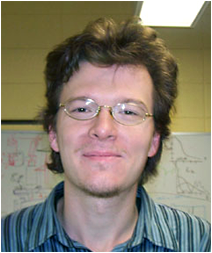 The COUPP collaboration has successfully used bubble chambers, a technology previously applied only to high-energy physics experiments, as direct dark matter detectors. It has produced the world's most stringent spin-dependent WIMP limits, and increasingly competitive spin-independent limits. These limits were achieved by capitalizing on an intrinsic rejection of the gamma background that all other direct detection experiments must address through high-density shielding and empirically-determined data cuts. The history of COUPP, including its earliest prototypes and latest results, is briefly discussed in this thesis. The feasibility of a new, windowless bubble chamber concept simpler and more inexpensive in design is discussed here as well. The dark matter limits achieved with a 15 kg windowless chamber, larger than any previous COUPP chamber (2 kg, 4 kg), are presented. Evidence of the greater radiopurity of synthetic quartz compared to natural is presented using the data from this 15 kg device, the first chamber to be made from synthetic quartz. The effective reconstruction of the three-dimensional positions of bubbles in a highly distorted optical field, with ninety-degree bottom lighting similar to cloud chamber lighting, is demonstrated. Another innovation described in this thesis is the use of the sound produced by bubbles recorded by an array of piezoelectric sensors as the primary means of bubble detection. In other COUPP chambers, cameras have been used as the primary trigger. Previous work on bubble acoustic signature differentiation using piezos is built upon in order to further demonstrate the ability to discriminate between alpha- and neutron-induced events. Related Links: KICP Members: Juan I. Collar KICP Students: Matthew Szydagis Scientific projects: COUPP/PICO |





 Overview
Overview